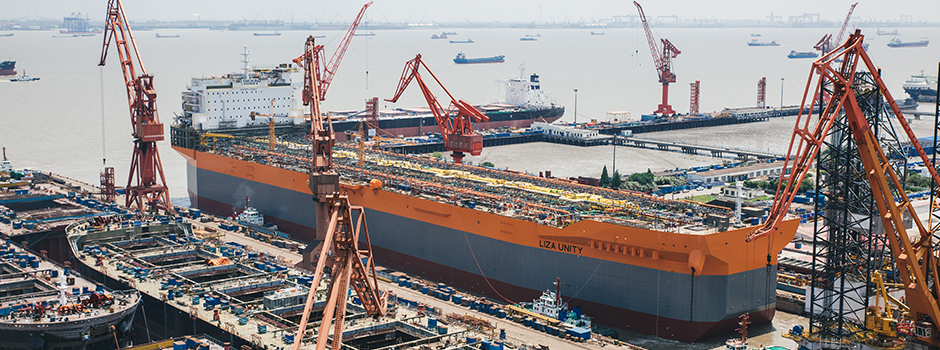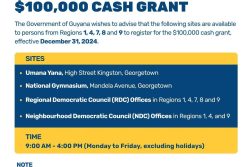Guyana’s next lift of a million barrels of oil is expected in May, around the same time the Department of Energy (DoE) projects that the 120,000 barrels of oil per day maximum production will be reached, but revenues received would likely be far less than the US$55M for the first lift given the current market conditions.
Why a smaller amount would be accrued, the Department of Energy’s Director Dr. Mark Bynoe reasons, is because this country decided that it would not hedge its 2020 five lifts of oil, but sell at current day Brent prices until it gets a substantive crude oil marketer to advise on future lifts.
Less money earned this year and the current global impact on the oil and gas sector is also expected to lower the projected 86% growth in GDP for this country, according to analysts and the DoE said it is currently crunching its own numbers to see just how much this country will be affected.
“Production is currently between 85, 000 and 90, 000 barrels per day. We are aiming to reach (maximum) production by May 2020. Guyana’s next lift is projected for May 2020. The depression in oil prices will impact Guyana’s revenue since Guyana did not hedge but used a dated Brent approach. However, no one knows what this impact will be, but we continue to monitor the situation,” Bynoe told Stabroek News.
Scenario
“No one knows exactly what the price will actually settle at. The DoE is completing various scenario analyses on projected COVID-19 and price fluctuations,” Bynoe said.
Asked to share excerpts of the department’s analysis about how much they believe this country would earn for the 2020 fiscal period, Bynoe said that he would not but that they are continuous. “No, we are not about to share our analyses, but we are doing various estimates,” he said.
When Guyana’s first one million barrels of crude was sold in February, this country received some US$55 million putting the price for one barrel of oil at about US$55, Minister of Finance Winston Jordan had said.
The Brent crude price for December, when production started, was at a high of US$67.31 per barrel and in February, the average was US$56 per barrel. The figure dropped earlier in March and then slumped dramatically into the mid-US$30s after a row between OPEC [the Organization of Petroleum Exporting Countries] and Russia.
By late March, oil futures settled under US$29 a barrel, down from US$61 at the start of the year, which Reuters said has cut new drilling and led producers to seek price cuts from suppliers. In early April it was even lower at US$20 per barrel and over the past few days seemed to be gaining ground as it rose again to about US$33 Brent.
On Thursday Saudi Arabia, Russia, and key OPEC allies agreed to slash crude oil production, a move that was expected to boost prices and bring some relief to the already troubling market.
But the volatility of the commodity again was evident as by late Thursday afternoon prices again began to tumble, closing at some US$31 per barrel.
The volatility of the market coupled with the overall possible effects of COVID-19 saw many analysts weighing in on the impact on Latin America and the Caribbean.
Lisa Viscidi, the Latin American Energy Specialist and Energy Programme Director at the nonprofit organisation, The Dialogue, this month wrote that the impact of the virus is already being felt in Guyana as this country had projected its high 86% growth rate on the petroleum sector.
“The oil price crash and coronavirus have compounded an inauspicious start to oil production in Guyana, which was previously projected to experience economic growth of 86 per cent this year. Fierce controversy over the vote-counting process following the election of March 2 has still not been resolved,” she said in an article for the oganisation titled ‘Pandemic and Price Collapse: Impacts for Energy in Latin America’.
Extension
And while the energy expert doesn’t believe that the price drop will affect ExxonMobil’s current operations, she said that it was a contributing factor to government’s recent extension of time for bids for a marketer for its share of oil from those operations.
Bynoe was asked if he believes that the current low price for crude impacted negatively on interests for marketers and if the DoE saw a decrease in possible marketing interests but he said that he was not aware it has.
But he pointed out that while interest here has not dwindled, this country will feel the overall global impact and this has already started affecting ExxonMobil’s operations.
When he was asked if there would be a delay in permits being issued to ExxonMobil for its Stabroek Block future operations due to COVID-19, he did not get specific with projects such as Payara or Hammerhead, but gave a general perspective.
“COVID-19 is impacting operations globally to which Guyana is not exempted. It is impacting crew change out, pace of work, cost of operations, etc. while the industry still seeks to institute the highest levels of occupational health and safety,” he said.
“In view of these events, the Department will continue to monitor the situation on a case by case basis and examine the merits of each case presented,” he added.
The Environmental Protection Agency (EPA) has said that COVID-19 will see a delay in permits granted on all future projects as it currently isn’t doing any field work and as such cannot hold EIA stakeholders’ meetings or conduct any site visits, a requirement before processing such applications.
“The company’s operations will be affected in that we the EPA cannot process and thus approve its application at this time due to COVID-19. We are not working and they would made certain projections and all of that, so in that sense, that would have to be pushed back,” Head of the EPA Dr. Vincent Adams explained.
ExxonMobil this week said that as a result of falling energy demand caused by the COVID-19 pandemic and reduced commodity prices, it was reducing its 2020 capital spending by 30 percent and lowering cash operating expenses by 15 percent.
Capital investments for 2020 are now expected to be about $23 billion, down from the previously announced $33 billion. The 15 percent decrease in cash operating expenses is driven by deliberate actions to increase efficiencies and reduce costs, and includes expected lower energy costs.
However, operations in the offshore Stabroek Block would not be affected. “Developing the numerous world-class deepwater discoveries offshore Guyana remains an integral part of ExxonMobil’s long-term growth plans. Current operations onboard the Liza Destiny production vessel are unaffected, and startup of the second phase of field development remains on target for 2022, with the Liza Unity production vessel currently under construction. As the company waits for government approval to proceed with a third production vessel for the Payara development, some 2020 activities are now being deferred, creating a potential delay in production startup of six to 12 months,” it said in a statement.
The company also underscored that it has put stringent novel coronavirus disease (COVID-19) safety measures in place for workers heading to and on its vessels in the offshore Stabroek Block.
“ExxonMobil Guyana is working to limit the disruption of the coronavirus to our operations,” the company’s Public and Government Affairs Advisor Janelle Persaud had told Stabroek News when contacted.
Screened
“Offshore workers are being screened at the Ogle heliport before they are cleared to travel offshore to ensure they are not exhibiting symptoms of the virus and that they have not …come in contact with anyone who has the virus,” she said.
Additionally, Persaud said, there are medical personnel onboard all of the company’s offshore facilities and they are “taking necessary precautions to monitor the health of the workers and provide appropriate treatment and care.”
But sources told this newspaper that the company instituted a lockdown on its offshore vessels and will adjust shift schedules to accommodate the changes.
While supplies will be taken out under the same stringent measures, there will be no crew changeover shifts for now.
ExxonMobil’s Chairman and CEO Darren Woods says that his company is very aware of the market conditions caused by the COVID-19 pandemic and commodity price decreases but they remain optimistic.
“This is an unprecedented environment, but our company has faced numerous market downturns throughout its long history, and we have experience operating in a sustained low-price environment. We remain focused on being a safe, low-cost operator and creating long-term value for shareholders,” he said.
“Energy has been called the engine of the economy and will be essential for the economic recovery that will follow. We’ll play an essential role in that recovery by doing what we do best – keeping our operations running safely, thoughtfully managing risk, and delivering the products that people around the world rely on,” he added.
Guyana’s Energy Director shares similar views for his country’s petroleum sector. “We wish Guyana was entering the market at a more buoyant period, but we remain bullish about the future and do think that the COVID-19 and the global market situation provide opportunities for increased efficiencies, greater consolidation and a complete re-examination of our business models and the assumptions underpinning those models. These can bring about positive changes, but they can also lead to reduced competition, a situation that will have to be monitored closely,” Bynoe said






